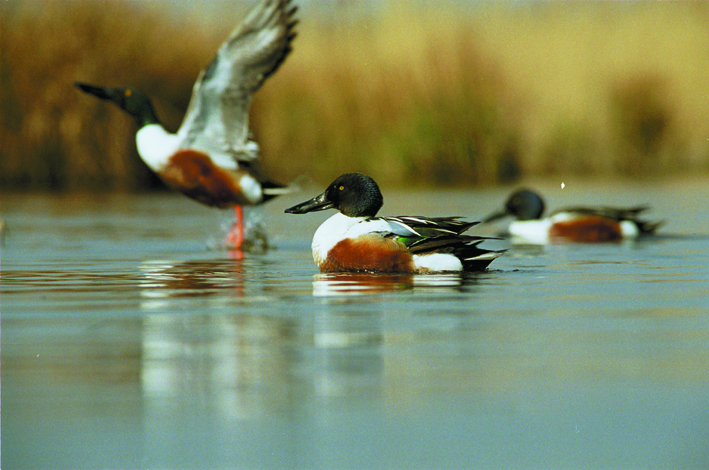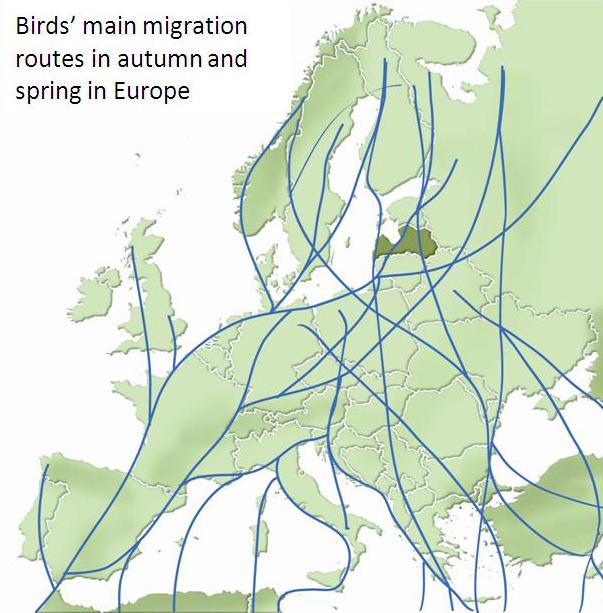 Another autumn has come, and the majority of birds nested, hatched or grown up in Latvia’s forests, countryside, swamps, lakes and other habitats leave for wintering areas. In October, nature enthusiasts have a chance to observe an impressive natural phenomenon – autumn bird migration. Latvia lies on the coast of the Baltic Sea – the path of migrating Baltic Sea birds. The majority of birds seen in Latvia in autumn are passers-by, spending their winters north of Latvia – in Estonia, Finland and Russia’s northwest region. Most of birds travelling to their wintering areas via Latvia – several species of geese, waders, ducks, singing birds - have nested or hatched in taiga or tundra.
Another autumn has come, and the majority of birds nested, hatched or grown up in Latvia’s forests, countryside, swamps, lakes and other habitats leave for wintering areas. In October, nature enthusiasts have a chance to observe an impressive natural phenomenon – autumn bird migration. Latvia lies on the coast of the Baltic Sea – the path of migrating Baltic Sea birds. The majority of birds seen in Latvia in autumn are passers-by, spending their winters north of Latvia – in Estonia, Finland and Russia’s northwest region. Most of birds travelling to their wintering areas via Latvia – several species of geese, waders, ducks, singing birds - have nested or hatched in taiga or tundra.
Latvian birds have wide wintering areas, ranging from Central Europe (mute swans), Western Europe (European robins), Southern Europe (blackcaps) to South Africa (swallows) and the coast of Antarctica (arctic terns).
Birds migrate not only by day, but also during night-time hours. Some bird species migrate while the sun is up, but a large number of birds, for instance, waders, warblers, buntings, starlings and others migrate when it is dark. Some birds can fly to their overwintering areas by day as well as by night, such as geese.
Although part of migratory birds leave Latvia already at the end of August and September, a keen nature watcher will be able to observe thousands of migrating birds through Latvia in October: great crested grebes, little grebes, great cormorants, whooper swans and tundra swans, greylag, bean and great white-fronted geese, mallards, wigeons, teals, pochards, tufted ducks, goldeneyes, common and read-breasted mergansers, little sparrowhawks, common and un rough-legged buzzards, white-tailed eagles, hen harriers, water rails, coots, lapwings, snipes, sandpipers, black-headed, little and common gulls, stock doves and wood pigeons, kingfishers, long-eared, short-eared and boreal owls, great spotted woodpeckers, woodlarks and skylarks, wrens, dunnocks, robins, blackbirds, song thrushes, redwings, mistle thrushes, meadow pipits, blackcaps, goldcrests, long-tailed, coal and great tits, treecreepers, jays, nutcrackers, rooks, starlings, linnets, chaffinches, bramblings, siskins, crossbills and other bird species. During the bird migration period, the keenest birdwatchers may be lucky to observe very rare bird species for Latvia.
During bird migration, birds can be observed all over Latvia, but there are places where higher concentrations of migratory birds may be observed. For instance, on shorelines, which serve as an important guide for both upland birds and waterfowl – especially if the shoreline runs north-south.
Birds not only fly over Latvia to their overwintering places. Thousands of birds land in Latvia to find food and rest here. That is why stubble fields present a good opportunity for birdwatchers – migrating geese, cranes, swans, songbirds and other birds feed and rest there. On the other hand, ducks prefer resting at lakes and other water bodies, while waders like shorelines.
Birds do not like migrating in rainy, windy and misty weather, therefore days with fine, sunny or partly cloudy weather, light to moderate winds and no precipitation or fog are the best for watching migratory birds. Best start at dawn, because that is when birds that were flying all night will be landing, whereas birds that migrate by day will be taking wing. If a birdwatcher happens to be at the sea on a day with fine weather for bird migration, he or she will see many songbirds. With enough patience, birds of prey will also appear sooner or later – little sparrowhawks, buzzards, maybe even an eagle or a falcon.
Of course, you will see many more birds, and much better, if you have binoculars with you. You can read more about best birdwatching methods here.
On a clear – and sleepless – night, you may want to go outside and listen for a while. A close listener will hear various bird sounds as they fly in the sky – geese, starlings, sandpipers and many others.
Although most birds that nest and hatch their young in Latvia will fly away in the autumn to their overwintering places, it does not mean that no birds will be left here in winter. There are many birds in Latvia, but of these we will tell you at the beginning of winter.
Information prepared by Kaspars Funts, head of the Latvian Bird Foundation

